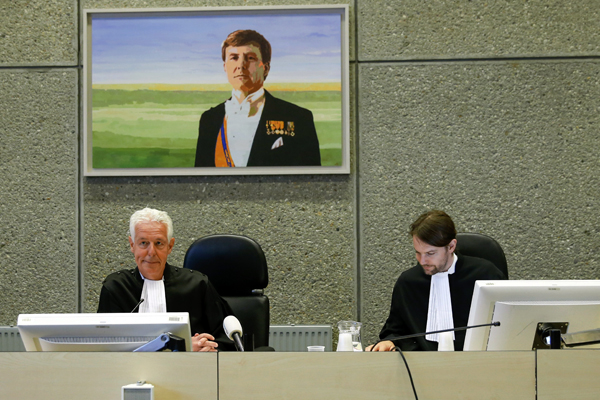Dutch court hears suit over stolen Buddha
 0 Comment(s)
0 Comment(s) Print
Print E-mail China Daily, July 17, 2017
E-mail China Daily, July 17, 2017
|
Judges hear the case brought by the villagers in Amsterdam on Friday. [Photo/Xinhua] |
Legal standing
Other issues were also brought up in court, such as the legal standing of the Chinese villagers in Dutch courts, and whether or not Van Overeem bought the statue in good faith.
Van Overeem claimed that the "Chinese village committee is not to be referred to as a natural person or legal person" under the Dutch Code of Civil Procedure, and "the claimants should be declared inadmissible in their claims".
Holthuis later told media outlets: "We have already argued that the village committee is a special legal person under Chinese law, and there is jurisprudence or case law in the Netherlands saying that even when you do not have legal presentation in terms of a legal entity, you can still file a claim.
"A lot of issues in this case have no case law," he told Xinhua. "Each time we almost have to invent the next step. But it doesn't mean we will fail."
Burning incense
On Thursday evening, dozens of villagers burned incense in Pu Zhao Tang, the temple in Yangchun, and prayed for the return of the missing statue.
In 2015, the village went through official and private channels to negotiate with the Dutch collector for the return of the statue after hearing media reports that the statue being displayed at a "Mummy World" exhibition at the Hungarian Natural History Museum in the capital, Budapest.
Villager Lin Wenqing said the Buddha had been worshipped in the village temple for more than 1,000 years, and even though the statue is no longer there, the villagers still hold a prayer ritual every year on Oct 5, the Bodhidharma Buddha's birthday according to the lunar calendar.
Liu Quan, a local man who became a monk in his 20s and adopted the name Zhang Gong, won fame for helping people by treating illnesses and spreading Buddhist beliefs.
When he died at age 37, his body was mummified as he had wished, and placed inside the statue.
"Master Zhang Gong was famous as a spiritual leader, because of the help he gave to those who needed it and because of his powers of healing. Upon his death, his body was protected against rotting through herbs and other means. Thereafter, the body was protected with a layer of lacquer and covered with a layer of gold," said Liu Yushen, a lawyer registered in Beijing who provides legal support to the villagers.
"The likely wish of monk Zhang Gong was that through mummification he would continue to have a spiritual and healing power on his environment after his death, and he would certainly not have agreed that his body would become the subject of (illegal) art trade," Liu told Xinhua.
"For villagers who live in a region that was the root of Buddhism in China, mummification has a special meaning. It implies that the body of the enlightened Buddhist monk remains part of the human world, and can still be defiled after his death by external influences. From generation to generation, the statue is worshipped and the day of the monk's death is still marked with pious ceremonies."
In March 2015, hundreds of Fujian residents signed a letter addressed to Mark Rutte, prime minister of the Netherlands, pleading for the return of the statue.
The letter, written in Chinese and English, was handed to European-Chinese groups in the Netherlands, which delivered it via the Chinese embassy.
"We believe this is the Buddha we have been searching for during the past 20 years and we look forward to its return," the letter said.







Go to Forum >>0 Comment(s)